The bonding strength
between TMT steel bars and concrete is a silent but powerful force that
determines the longevity and stability of structures. TMT steel bars, with
their unique manufacturing process, play a pivotal role in ensuring a robust
connection with concrete, fortifying buildings against the tests of time,
natural forces, and structural stresses. In this post, we delve into the
fascinating world of TMT steel bars and unravel the significance of their
bonding strength in maintaining the structural integrity of buildings.
Importance of Bonding Strength
The structural synergy between TMT Steel Bars in Amritsar and concrete is a critical factor in ensuring the stability and strength of buildings. The bonding strength represents the force that resists separation between the steel and concrete, essentially determining how well these two materials work together to withstand external forces and structural loads.
Enhanced Ductility and Flexibility
One of the key benefits of
a robust bond between TMT steel bars and concrete is the enhanced ductility and
flexibility it provides to the structure. The unique combination of strength
and flexibility in TMT steel allows structures to deform without catastrophic
failure under extreme conditions like earthquakes. The steel-concrete bond
ensures that the building can withstand significant stress, preventing sudden
collapses and ensuring the safety of occupants.
Preventing Corrosion and Rust
The bond between TMT steel
bars from the Best TMT Steel Bars Supplier in Amritsar and concrete acts as a
protective shield against corrosion and rust - two common adversaries of
structural integrity. The outer layer of TMT steel undergoes a process called
passivation during manufacturing, forming a protective oxide layer that shields
the steel from environmental factors. The strong bond with concrete further
prevents the intrusion of moisture and aggressive agents, safeguarding the steel
against corrosion and extending the lifespan of the structure.
Shear Transfer Capacity
In structures subjected to lateral loads or forces, such as wind or seismic events, shear transfer capacity is crucial for maintaining stability. The bond between TMT steel bars and concrete enhances shear transfer, ensuring that the forces acting on the structure are effectively distributed. This property is particularly vital in high-rise buildings, bridges, and other structures where shear forces can pose a significant threat to stability.
Improved Load Distribution
The effective distribution
of loads across a structure is fundamental to preventing localized stress
concentrations. The bond between TMT steel and concrete plays a pivotal role in
achieving uniform load distribution. This not only enhances the overall
strength of the structure but also minimizes the risk of structural failures
due to uneven stress distribution.
Ensuring Structural Continuity
The seamless connection
between TMT steel bars and concrete ensures structural continuity throughout
the entire building. This continuity is vital for transferring loads from one
part of the structure to another, creating a unified and robust system. It
prevents the development of weak points that could compromise the overall
integrity of the building.
Construction Best Practices for Optimal Bonding
Strength
Achieving optimal bonding
strength between TMT steel bars and concrete requires adherence to construction
best practices. Here are some key considerations:
Surface Preparation: Properly clean and
prepare the surface of TMT steel bars before concrete placement. Any impurities
or contaminants on the steel surface can hinder the bond formation.
Proper Reinforcement
Placement:
Ensure accurate and proper placement of Top TMT Rebars in Amritsar within
the concrete structure. This includes maintaining the specified spacing, cover,
and alignment to optimize the bond between the steel and concrete.
Quality Concrete Mix: Use a high-quality
concrete mix with the right proportion of ingredients. A well-designed concrete
mix contributes to the overall durability and strength of the structure.
Compaction: Adequately compact the
concrete during placement to eliminate air voids and ensure intimate contact
between the concrete and TMT steel bars. Proper compaction enhances the bond
and reduces the risk of voids that could compromise structural integrity.
Curing: Implement a proper curing regime for the concrete to prevent premature drying and ensure optimal strength development. Adequate curing is essential for the long-term durability of the bond between TMT steel and concrete.
TMT Steel Rods: Nurturing Stability Through the Invisible Bond with Concrete
The bonding strength between
TMT steel bars and concrete emerges as a silent guardian, ensuring the
strength, stability and longevity of structures. The evolution of TMT steel
bars offered by Shri Rathi Group, the best TMT Steel Bars Manufacturer in Amritsar has
revolutionized the construction industry by providing a material that combines
strength, ductility and resilience.
As builders and engineers continue to push the boundaries of design and construction, the bond between TMT steel and concrete stands as a testament to the harmonious collaboration of materials, building structures that endure the trials of time and the forces of nature. Through meticulous attention to construction practices and a deep understanding of the interplay between materials, we pave the way for a future where structures not only stand tall but stand the test of time with unwavering strength and stability.


.jpeg)




No comments:
Post a Comment